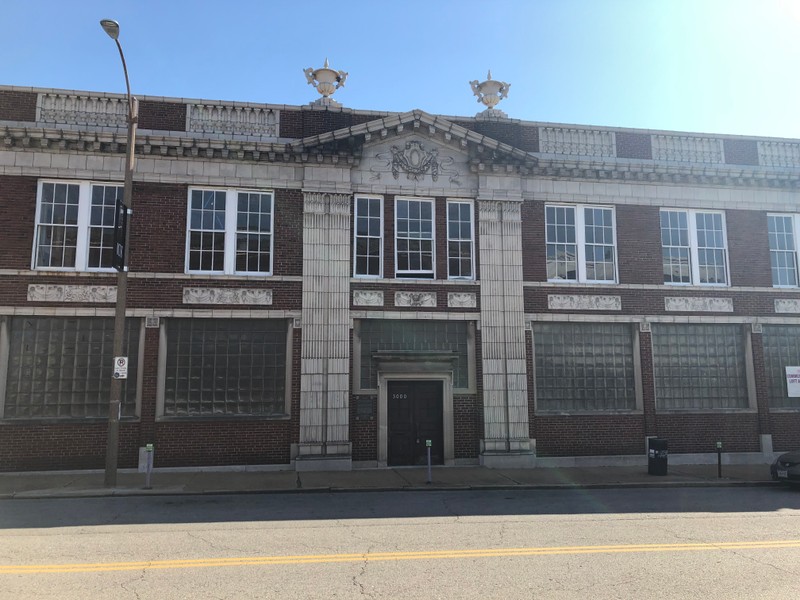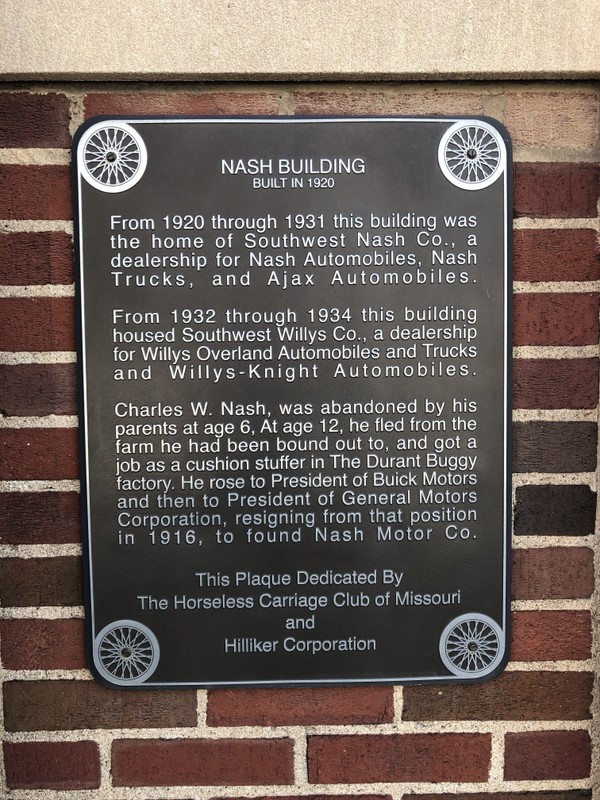Nash Building
Introduction
Text-to-speech Audio
Constructed in 1920, the Nash Building operated as part of Automotive Row during the early part of the twentieth century. From 1911 to 1955, the district supported a plethora of early automotive distribution, sales, and service properties on Olive and Locust Streets. By the mid-1910s, Locust Street served as the epicenter of Automobile Row, with numerous automotive-related businesses operating in the buildings surrounding this historic structures. From 1932 through 1934, Southwest Willys Co., a dealership for Willys Overland Automobiles and Trucks and Willys-Knight Automobiles, occupied this building which have recently been converted to apartments.
Images
Nash Building, built in 1920. It sits on historic Automobile Row in St. Louis

Nash Building historical marker in St. Louis

Backstory and Context
Text-to-speech Audio
Before evolving into Automobile Row during the 1910s, the area primarily functioned as a residential neighborhood. From the 1850s to the 1880s, an abundance of residences moved west from downtown St. Louis into what became the Automotive District. The arrival of the Grand Avenue Railway Company in 1867 and, later, a streetcar line helped the area develop into an urban residential neighborhood known as "Midtown," which supported numerous shops, hotels, theaters, and bicycle shops.
Even as late as 1909, Locust Street remained mainly residential, but a change was on the horizon; automotive shops and dealers began to appear by 1911, interwoven with such commercial enterprises as grocers, printers, pharmacies, saloons, and hotels. Efforts to widen streets in the region made the area increasingly automobile friendly. In 1917, the newly formed St. Louis City Plan Commission proposed a plan to widen many of the city's streets to reduce traffic and congestion, especially in areas where urban expansion had rapidly overtaken former residential areas. By the time bond issues passed in the 1920s, Locus Street had already supported numerous automotive industry establishments.
During the early 1930s, diminished commercial activity along Locust reflected the nationwide economic struggles known as the Great Depression. Many businesses closed, while several automotive parts and service companies diversified their product selection to stay in business. By 1932, businesses alongside automotive stores included a restaurant, a sign company, a printer, and a telephone company. Automotive-related businesses enjoyed growth after World War II, but Automotive Row by then supported both car-related businesses and operations without connections to the automobile industry.
Moroever, dealerships slowly moved away from Automotive Row after the war as automobile dealers required modern facilities. The dealers had to compete with Packard and "the Big Three" (Ford, Chrysler, and General Motors), which required that dealerships offer more to customers, including large showrooms, multiple models on display, financing capabilities, and a full-service area. Such demands required that buildings be constructed significantly larger and located in prime locations that Locust Street could not provide. Still, during the '40s and '50s, auto repair shops, paint and body shops, supply stores, and service stations remained in business and thrived.
From 1920 through 1931, the Nash Building served as the home to Southwest Nash Co., a dealership for Nash automobiles, Nash Trucks, and Ajax Automobiles. It stood across from the Ford Building, and among numerous other auto dealerships and related businesses on Locust Street.
Charles W. Nash's first job in the auto industry involved stuffing cushions for The Durant Buggy factory. But, he climbed the proverbial corporate ladder, eventually becoming president of Buick, (1910-1912) and then the head of General Motors (1912-1916). In 1916, he founded the Nash Motor Company.
Much of the Nash Company's early success involved Nash's reliance on his chief engineer, Nils Erik Wahlberg, an early proponent of wind tunnel tests for vehicles. Wahlberg also gets credit as one of the first designers of the car ventilation system, which among many things, helped balance the pressure between the vehicle's interior and the outside environment. Nash cars relied on an overhead in-line eight-cylinder engine (an idea borrowed from Buick), dual ignition, and, in the Ambassador Eight of 1932, a fully synchronized transmission, automatic central lubrication, and adjustable suspension.
Nash introduced the affordable Ajax automobile brand in 1925, which one could purchase in St. Louis. Because sales did not meet expectations, the Ajax became the Nash Light Six in 1926; sales promptly increased.
From 1932 through 1934, Southwest Willys Co., a dealership for Willys Overland Automobiles and Trucks and Willys-Knight Automobiles, occupied the building.
Sources
"Historical Essay: Charles W. Nash and the Nash Motor Company." Wisconsin Historical Society. Accessed September 23, 2022. https://www.wisconsinhistory.org/Records/Article/CS344#:~:text=Nash%20founded%20the%20Nash%20Motor,and%20switched%20to%20producing%20automobiles.
Jones, Devery Becker. "Nash Building: Built in 1920." The Historical Marker Database. HMdb.org. April 29, 2019. https://www.hmdb.org/m.asp?m=133092.
Keenov, Ruth, Karen Bode Baxter, Timothy P. Malonev, and Mandv K. Ford. "Registration Form: Locust Street Automotive District." National Register of Historic Places. mostateparks.com. 2005. For specific architectural details, see "Nash Saint Louis Motor Company Building," in Section 7, page 6.
"Nash Motors History." Motor Car (blog). motor-car.net. Accessed September 23, 2022. https://motor-car.net/nash/item/12273-nash-motors-history.
Photographed By Devry Becker Jones, April 22, 2019. https://www.hmdb.org/m.asp?m=133092
Photographed By Devry Becker Jones, April 22, 2019. https://www.hmdb.org/m.asp?m=133092
